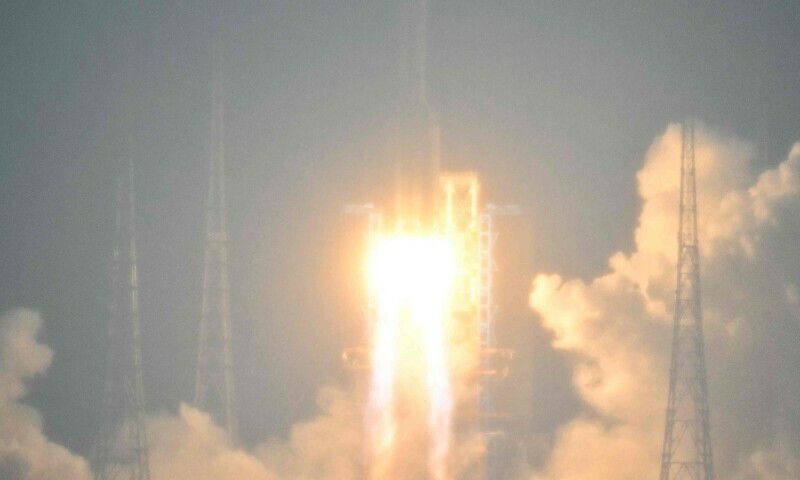Islamabad : May 3,2024 :. Pakistan’s satellite ‘iCube Qamar’ along with China’s space mission ‘Cheng E6’ has left to orbit the moon. The iCube Q is equipped with two optical cameras that are used to take pictures of the lunar surface.
After successfully passing through the testing and qualification phase, ‘IQUQ’ has been attached to the ‘CHENG 6’ mission. The satellite was launched from the Wencheng Space Center in Hainan, China, after which Pakistan placed it in lunar orbit. It has become the sixth country to launch a satellite. Satellite iCube Qamar took off at 02:27 on May 3, 2024, which was broadcast live on Chinese media and the website of the Institute of Space Technology. The mission’s departure witnessed emotional scenes at SPARCO, SPARCO Command and Control. The center erupted with applause, people chanted Takbeer and Pakistan Zindabad. ‘iCube Qamar’ has been designed and developed by Institute of Space Technology in collaboration with Shanghai University of China and Pakistan National Space Agency ‘SPARCO’. It is the world’s first mission to retrieve samples from the other side of the Moon, the Pakistani satellite ‘iCube Qamar’ is equipped with two optical cameras used to take pictures of the lunar surface. After successfully passing through the testing and qualification phase, ‘iCube Q’ has been attached to China’s ‘Cheng-6’ mission. A live broadcast of the historic space mission’s departure can be seen below
Institute of Space Technology Member Core Committee Dr. Khurram Khurshid said that the satellite will reach the lunar orbit in 5 days. Pakistan’s satellite mission will orbit the moon for 3 to 6 months, with the help of the satellite, various images of the moon’s surface will be taken, after which Pakistan will have its own satellite images of the moon for research. The satellite belongs to Pakistan, we will use its data, but since it is being transmitted to the moon using China’s network, Chinese scientists can also use this data. This satellite has been developed in a short period of 2 years. Dr Khurram Khurshid said that it would not be fair to compare Pakistan’s mission with India’s Chandrayaan because Chandrayaan was the big mission that landed on the Moon but the iCube Qamar, a small satellite, will orbit the Moon. “But this is a small project initially to pave the way for bigger missions in the future,” he said. Dr Khurram Khurshid said that this is the first mission in the world that will get samples from the other side of the moon. This mission will last 53 days. Will try to lift a substance up to kg.
On the other hand, General Manager IST Syed Samar Abbas said that this mission will provide important information about the Moon’s weather, Earth and magnetic field. He said that in 2022, the Chinese National Space Agency through the Asia Pacific Space Corporation Organization (APSCO) provided a unique opportunity for member countries to reach the lunar orbit for free. Samar Abbas said that the member countries had sent their plans on the proposal of Epsco. The member countries of Epsco include Pakistan, Bangladesh, China, Iran, Peru, South Korea, Thailand and Turkey.
Pakistan’s Institute of Space Technology also submitted a proposed project, out of 8 countries, only Pakistan’s project was accepted. After two years of hard work, the satellite ‘iCube Qamar’ was completed. The Chang’e 6 mission aims to collect samples from the surface of the Moon and these samples will then be brought back to Earth where scientists will further study the composition, history and formation of the Moon. This mission is also of great importance to Pakistan as it also carries the CubeSat satellite ‘IcubeQ’ developed by the Institute of Space Technology. Satellites ‘iCube Q’ satellites are known for their small size and standard design. Cube sets are built in a cubic shape and are made of modular components that adhere to specific size criteria. These satellites often weighed no more than a few kilograms and were launched into space for various purposes. The primary purpose of CubeSats is to facilitate scientific research, technological development and educational projects related to space exploration. CubeSats have been used for a variety of missions, such as observing the Earth, studying the atmosphere, remote sensing, facilitating communications, astronomy and demonstrating new technologies
Pakistan’s historic space mission ‘iCube Qamar’ launched
Next Post

